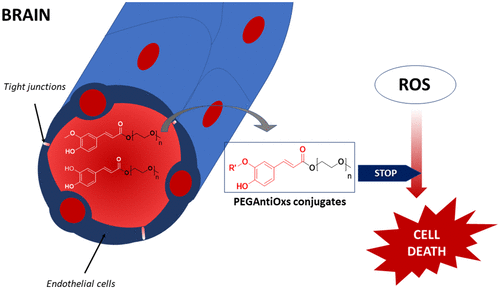当前位置:
X-MOL 学术
›
Bioconjugate Chem.
›
论文详情
Our official English website, www.x-mol.net, welcomes your
feedback! (Note: you will need to create a separate account there.)
Development of a PEGylated-Based Platform for Efficient Delivery of Dietary Antioxidants Across the Blood–Brain Barrier
Bioconjugate Chemistry ( IF 4.0 ) Pub Date : 2018-04-11 00:00:00 , DOI: 10.1021/acs.bioconjchem.8b00151 Carlos Fernandes 1 , Miguel Pinto 1 , Cláudia Martins , Maria João Gomes , Bruno Sarmento 2 , Paulo J. Oliveira 3 , Fernando Remião , Fernanda Borges 1
Bioconjugate Chemistry ( IF 4.0 ) Pub Date : 2018-04-11 00:00:00 , DOI: 10.1021/acs.bioconjchem.8b00151 Carlos Fernandes 1 , Miguel Pinto 1 , Cláudia Martins , Maria João Gomes , Bruno Sarmento 2 , Paulo J. Oliveira 3 , Fernando Remião , Fernanda Borges 1
Affiliation

|
The uptake and transport of dietary antioxidants remains the most important setback for their application in therapy. To overcome the limitations, a PEGylated-based platform was developed to improve the delivery properties of two dietary hydroxycinnamic (HCA) antioxidants—caffeic and ferulic acids. The antioxidant properties of the new polymer–antioxidant conjugates (PEGAntiOxs), prepared by linking poly(ethylene glycol) (PEG) to the cinnamic acids by a one-step Knovenagel condensation reaction, were evaluated. PEGAntiOxs present a higher lipophilicity than the parent compounds (caffeic and ferulic acids) and similar, or higher, antioxidant properties. PEGAntiOxs were not cytotoxic at the tested concentrations in SH-SY5Y, Caco-2, and hCMEC/D3 cells. By contrast, cytotoxic effects in hCMEC/D3 and SH-SY5Y cells were observed, at 50 and 100 μM, for caffeic and ferulic acids. PEGAntiOxs operate as antioxidants against several oxidative stress-cellular inducers in a neuronal cell-based model, and were able to inhibit glycoprotein-P in Caco-2 cells. PEGAntiOxs can cross hCMEC/D3 monolayer cells, a model of the blood-brain barrier (BBB) endothelial membrane. In summary, PEGAntiOxs are valid antioxidant prototypes that can uphold the antioxidant properties of HCAs, reduce their cytotoxicity, and improve their BBB permeability. PEGAntiOxs can be used in the near future as drug candidates to prevent or slow oxidative stress associated with neurodegenerative diseases.
中文翻译:

有效地通过血脑屏障输送膳食抗氧化剂的基于聚乙二醇化的平台的开发
饮食中抗氧化剂的摄取和运输仍然是其在治疗中应用的最重要的障碍。为了克服这些限制,开发了一种基于聚乙二醇化的平台,以改善两种饮食性羟基肉桂酸(HCA)抗氧化剂(咖啡酸和阿魏酸)的递送特性。评估了一种新的聚合物-抗氧化剂偶联物(PEGAntiOxs)的抗氧化性能,该偶联物是通过一步式Knovenagel缩合反应将聚乙二醇(PEG)与肉桂酸连接而成的。PEGAntiOxs具有比母体化合物(咖啡酸和阿魏酸)更高的亲脂性,并且具有相似或更高的抗氧化特性。在SH-SY5Y,Caco-2和h CMEC / D3细胞中,PEGAntiOxs在测试浓度下没有细胞毒性。相比之下,h中的细胞毒性作用分别以50和100μM的浓度观察到CMEC / D3和SH-SY5Y细胞的咖啡酸和阿魏酸。PEGAntiOxs在基于神经元细胞的模型中作为抗多种氧化应激细胞诱导剂的抗氧化剂,并能够抑制Caco-2细胞中的糖蛋白-P。PEGAntiOxs可以跨越ħ CMEC / D3单层细胞,血-脑屏障(BBB)的内皮膜的模型。总之,PEGAntiOx是有效的抗氧化剂原型,可以维持HCA的抗氧化特性,降低其细胞毒性,并提高其BBB渗透性。PEGAntiOxs可以在不久的将来用作预防或减缓与神经退行性疾病相关的氧化应激的候选药物。
更新日期:2018-04-11
中文翻译:

有效地通过血脑屏障输送膳食抗氧化剂的基于聚乙二醇化的平台的开发
饮食中抗氧化剂的摄取和运输仍然是其在治疗中应用的最重要的障碍。为了克服这些限制,开发了一种基于聚乙二醇化的平台,以改善两种饮食性羟基肉桂酸(HCA)抗氧化剂(咖啡酸和阿魏酸)的递送特性。评估了一种新的聚合物-抗氧化剂偶联物(PEGAntiOxs)的抗氧化性能,该偶联物是通过一步式Knovenagel缩合反应将聚乙二醇(PEG)与肉桂酸连接而成的。PEGAntiOxs具有比母体化合物(咖啡酸和阿魏酸)更高的亲脂性,并且具有相似或更高的抗氧化特性。在SH-SY5Y,Caco-2和h CMEC / D3细胞中,PEGAntiOxs在测试浓度下没有细胞毒性。相比之下,h中的细胞毒性作用分别以50和100μM的浓度观察到CMEC / D3和SH-SY5Y细胞的咖啡酸和阿魏酸。PEGAntiOxs在基于神经元细胞的模型中作为抗多种氧化应激细胞诱导剂的抗氧化剂,并能够抑制Caco-2细胞中的糖蛋白-P。PEGAntiOxs可以跨越ħ CMEC / D3单层细胞,血-脑屏障(BBB)的内皮膜的模型。总之,PEGAntiOx是有效的抗氧化剂原型,可以维持HCA的抗氧化特性,降低其细胞毒性,并提高其BBB渗透性。PEGAntiOxs可以在不久的将来用作预防或减缓与神经退行性疾病相关的氧化应激的候选药物。











































 京公网安备 11010802027423号
京公网安备 11010802027423号